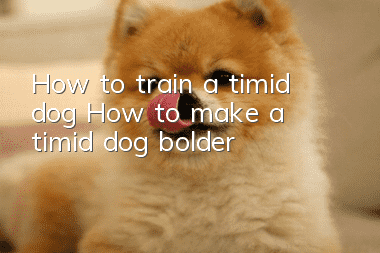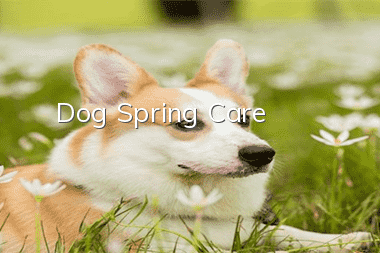How to train a timid dog How to make a timid dog bolder

First achieve a very strong affinity with the dog
You feed the dog your own food, comb and wipe the dog's hair to make the dog feel comfortable, stroke the dog often, and call the dog's name. Play interactive games with your dog regularly. Once these dogs become more familiar with you, they will become better and better.
Train while playing. You must stay in the most excited state when playing and stop when you are most excited. He will still be very interested in playing with it next time. If you wait until the dog stops playing and ignores you before you stop, he will not be so excited about playing with it next time and his interest will be greatly reduced.
Game method
1. Let your dog like tug-of-war toys such as chewing hemp sticks. In tug-of-war, you have to find ways to tease him, drag him on the ground, or disturb him to make him want to bite.
2. The time cannot be too long, as long as the effect is good. Take away the toy after playing with it, and his desire will become stronger and stronger next time. If he does well next time, the time can be longer.
3. When playing, as long as he bites, say the bite command. Then give action rewards or verbal rewards from time to time. Give it to him after tugging on it, and reward him immediately to make him feel satisfied. This will make you more interested in the future.
4. If the dog behaves very well. Add movement to the bite. First, add the soft stick as if you are going to hit him. The movement must be as slow as possible. As long as he spits. Just take the hemp stick and leave. It means he can't play without biting. Play again after a while or longer. Until he is no longer afraid and adapts. After adapting, it will take some time to consolidate and then increase training.
5. After he adapts. The action can be increased in the future. Met him first. After adapting. There is strength to touch him again. Gradually you will succeed.
6. Later, the supplementary bite will be naturally trained. Ask him to bite and he will bite. Not afraid of being beaten.
Those who train must have perseverance. If you can’t do it, you can’t train. Don’t be impatient
The above is only an example of playing games. The principle is the same. You can play other different games. For example, protect the sleeves,
It is very important to encourage your dog in daily life. When he is a little scared, it will be much better if you encourage him. It may be difficult to understand if there are too many words. Just master it slowly.
The first stage is the puppy training stage, which mainly cultivates the dog's courage so that it is not afraid of strangers and can actively bark or attack.
Method 1: The trainer takes the puppy to the training venue, asks the dog to pay attention to the assistant, and pretends to drive the assistant away. The assistant should pretend to be scared and run while teasing. . When the puppy barks or even attacks the trainer, the trainer will promptly encourage the dog and fully reward it.
Method 2: Use multi-headed dogs to bark and attack in groups. The specific method is the same as above.
The second stage is the training stage (the dog is over 10 months old), which can be divided into three steps.
1. Group games and the cultivation of proactive desire to attack. The method is that the trainer pulls the dogs to stand in a row or arc shape, and the assistant trainer wears a protectiveTease with sleeves, usually 2 to 3 times. When the dog's desire to attack is very high, let the dog pounce once, and then tease it 1 to 2 times to end. Then transition to a single dog that steps forward and bites at a distance.
2. Cultivation of the ability to bite from a distance by releasing the rope. The method is that the trainer first holds the dog, and the assistant trainer teases it and then runs away. After running 10 to 15 meters, the trainer leads the dog to attack the assistant trainer. Finally, the dog can successfully attack designated targets within 50 meters.
3. Cultivation of fighting skills in complex environments. The method is, practice training, such as dispersing small groups, dogs with good qualities, aggressive and active, basically meet the actual combat requirements.
The ferocity of dogs is related to genetics. Strong active defense reflexes in genetics indicate ferocity. However, the behavior of puppies has strong plasticity, and its own behavior can be improved through acquired training. A puppy with a strong passive defense reflex will gradually become bolder and more ferocious if properly trained. Therefore, dog ferocity training plays a vital role.
The purpose of cultivating the ferocity of puppies is to cultivate the dog's courage and aggressive behavior, laying the foundation for future bite subjects. The puppies are required to form a conditioned reflex to the "attention" and "attack" commands. The puppy can bite the assistant trainer according to the owner's gestures and commands, and the puppy's performance
Bold and fierce, they do not fight with each other.
What methods are used to train courage
1. Use the dog’s defensive response to cultivate the dog’s ferocity
Use strangers to tease, the courage of puppies can be Developed by encouraging it to attack the provocative person.
Some puppies are born timid, and it is difficult to cultivate their bravery individually. You can use the method of multi-headed dogs to attack in groups and encourage each other to be brave. Since puppies are relatively less courageous, choose 1-2 ferocious dogs to take the lead in attacking, and timid puppies can follow suit. Therefore, the early training of puppies to attack and bite should be carried out on the basis of group dogs attacking and biting. However, training should be carried out in an environment that the dog is familiar with to eliminate the dog's passive defense reaction. Gather several puppies of different sizes of courage together, and an assistant trainer will start to approach the dog with small and sneaky movements, and tease the dog while keeping a certain distance from the dog. Among them, the bolder dog will There will be an active defensive reaction in the assistant trainer.
Remind you that when the dog shows an intention to bite, the assistant trainer should retreat appropriately in a timely manner. The trainer provides sufficient reinforcement rewards to the dog to cultivate the dog's "self-confidence". After several such trainings, dogs with less courage will show the desire to bite along with other dogs. The trainer must strengthen the dog in a timely manner. It is best to use food rewards as reinforcement at this time. Gradually increase the range of movements as the dog adapts to the trainer's behavior.
Each training session should end with the dog’s “victory”. For puppies with low hostility or dominant passive defense, supposeThe enemy's actions should be different. For the former, try to be as sneaky as possible and move with a wider range of motion, while for the latter, just the opposite. Running past the puppy provocatively, or teasing the dog directly to arouse the dog's anger. These methods can increase the puppy's hatred and enthusiasm for biting. When the puppy barks at the assistant trainer or behaves aggressively, , the trainer should make a "fleeing in panic" look, and the owner should fully reward the puppy's brave behavior. Under any circumstances, the trainer cannot talk or laugh with the assistant trainer in front of the dog, as this will reduce the dog's hatred towards him. The cultivation of bravery will end with the puppy "victory" every time. When puppies are aggressive to a certain extent, care should be taken to ensure safety when being released to prevent them from chasing animals, livestock, or biting and scaring pedestrians.
2. Use the food reflex of puppies to cultivate ferocity
Some puppies have strong food reflexes and do not allow strangers or others to approach when eating. You can use this instinct to cultivate bravery. Training should be carried out before feeding the dog. Tie the puppy up and place a bowl of food next to it. An assistant trainer will gradually approach the food bowl and make a sneaky show of taking the dog's food bowl. This is the puppy's instinct to protect food. Yelling. When starting training, the training assistant should approach the dog bowl in a sneaky and fearful manner. When the puppy shows aggression or barking, the trainer should immediately come out and drive away the assistant trainer, and give the puppy the food bowl so that it can eat food. and strengthen. After repeated training, the dog's ferocity can be gradually improved.
3. Tease the bite object
Use a towel to make a soft bite object and tease it as necessary. First, the puppy is trained to pick up the towel roll, and then an assistant trainer takes the small bite away from the dog's mouth when the dog is not paying attention. And tease the dog appropriately. It rushes forward eager to get something to bite and barks along with it. After the dog barks, give the "attack" command in time, let the dog bite the towel roll, pull it slightly and then give the bite object to the dog. After many times of such training, the dog's ferocity can be cultivated and the dog can be excited about biting. Puppy bites can be carried out 1-2 times a day. Because it is affected by the age and constitution of the dog, the bite must not be inhibited because the dog is too tired.
Through the above cultivation of the puppy's hatred and courage, the dog can develop a good habit of being excited about biting from an early age. Lay a good foundation for future bite training. When the dog reaches the age of 5 months, the dog can be trained in the primary stage of biting.
- The dog inhales vigorously, as if it’s a twitch
- What is the personality of the Irish Soft Coated Terrier?
- How much weight can Teddy grow?
- The most effective way to reduce fever in Teddy dogs
- What snacks can a dog over one month old eat?
- The dog suddenly stopped eating and only drank water
- How much dog food should a two-month-old Samoyed eat in a day? His intestines and stomach are still very fragile!
- The dog ate black deoxidizer. Do you know how to correctly help the dog induce vomiting?
- Blogger Yu Ya was subjected to domestic violence. The domestic violence man also abused the dog! What an unforgivable sin!
- Can dogs eat chocolate? Try not to feed it to your dog!



